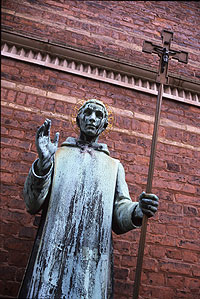
Ansgar was born in the year 801 in Picardy in France. After his mother’s death he lived at the abbey school in Corbie in the north of France. As a young man he was transferred to the abbey in Corvey on the River Weser. There he learned, among other things, to speak Saxon, a language which was so close to the Danish of that time that the speakers could understand each other.
The journey to the Nordic mission field
In the year 825 Harald, a Danish descendant of kings, visited the Emperor Louis the Pious in Aachen. There he was baptised – in order to receive military support from the emperor – and he received rich gifts and the promise of military aid to win the Danish throne. Louis the Pious also insisted that Harald took a couple of missionary priests with him to Denmark. It was the two monks Ansgar and Aubert who undertook the perilous task.
Birka 829-831
Missionary work was difficult both in Hedeby and Friesland, and when Ansgar had the opportunity to go to Birka in Sweden in 829, he seized it eagerly. The journey to Birka was very dramatic because the merchant ship he sailed on was attacked by pirates, who, among other things, stole Ansgar’s holy books. Ansgar saved himself by jumping overboard and swimming ashore. He continued on foot to Birka, where he was received by King Birger. The stay in Birka lasted until 831 and yielded good mission results.
Nordic mission archiepiscopal see in Hamburg
On his return home, Ansgar was ordained archbishop in Hamburg because of his good mission results. He was responsible for the Elbe area, Holstein, Stormarn, the Ditmarshes and the whole of the North. In Ansgar’s time there were probably no more than 4 or 5 churches in this whole area. In the following years there was great unrest around the archiepiscopal see. Because of Viking raids with pillage and burnings, Ansgar eventually had to flee from Hamburg. Later he was consecrated as archbishop of Hamburg-Bremen.
Church construction in Hedeby
From 849 the political situation had improved so much that Ansgar could resume his missionary work in Hedeby. In 850 the Danish King Haarik gave ham permission to preach the Christian faith and build a church. This became the first church in Denmark. The king donated the site and decided that a priest must always be present. The king had a favourable attitude to Ansgar’s work, and on several occasions Ansgar acted as the king’s emissary to the German imperial court, but the king was never baptised. Many people were marked with the sign of the cross but not actually baptised, and it seemed that a Danish Christian community was emerging. In 854 the ringing of church bells became allowed in Hedeby. Till then it had been forbidden because of fears that the bell would frighten the good spirits of the family away!
Church construction in Ribe
The Danish king also donated a site for the building of a church in Ribe and gave permission to start the construc- tion work. It is not known for certain if the church was finished in Ansgar’s lifetime.
Ansgar’s death
Ansgar died on the third of February 865 in Bremen, where he was buried in front of the high altar in the Church of Saint Peter. Immediately after his death, his successor began to compose a biography, written ‘for the glory of God, the edification of the readers and so that pious men may imitate it’.
Ansgar in the Middle Ages
From the perspective of our time, the results of Ansgar’s work were not great. Shortly before his death, he said himself: ‘The church of Christ is founded among the Danes and the Swedes, and priests carry out their vocation without hindrance’. Because of Ansgar’s work, Christianity could be preached without hindrance at the most important trading centres, but there was no real change of religion in the North until approximately 100 years later.
Ansgar today
Throughout the Middle Ages there are not many signs that Ansgar was venerated as a saint in the North. And to our knowledge, no Danish church was dedicated to his name. As a typical man of action, he devoted his life to the Nordic mission. He threw himself into the task with daring, he made plans and followed them tirelessly, and it is therefore with good reason that he is called ‘the Apostle of the North’.

